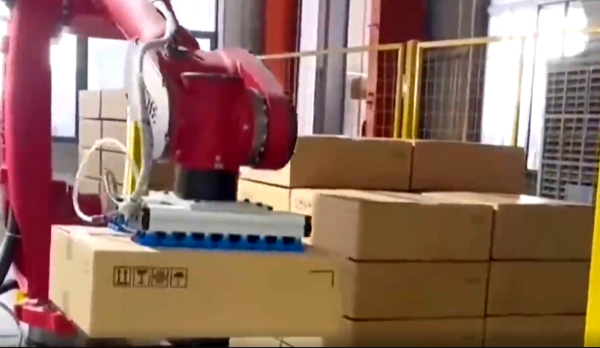Correct selection and installation
Accurate selection: When choosing a four axis palletizing robot, multiple factors need to be considered comprehensively. The key parameters of the robot, such as load capacity, working radius, and movement speed, should be determined based on the maximum weight and size of the cardboard box, as well as the height and speed requirements of the palletizing. This ensures that the robot will not be overloaded for a long time due to selecting too small a size, which will affect its service life in actual work. For example, if the cardboard boxes are heavy and the stacking height is high, it is necessary to choose a robot model with a larger load capacity and longer working radius.
Reasonable installation: When installing the robot, ensure that the installation foundation is firm, flat, and able to withstand the vibration and impact force generated by the robot during operation. At the same time, precise installation should be carried out according to the robot's installation manual to ensure the parallelism and perpendicularity between each axis, so that the robot can receive even force during movement and reduce additional wear on mechanical components caused by improper installation.
Standardized operation and training
Strict operating procedures: Operators must strictly follow the operating procedures of the robot and check whether the various components of the robot are normal before starting up, such as whether the movement of each axis is smooth and whether the sensors are working well. During operation, attention should be paid to observing the working status of the robot, and unnecessary intervention or operation is strictly prohibited to prevent accidents such as collisions.
Professional training to enhance skills: Comprehensive and professional training for operators is crucial. The training content should not only include basic operational skills, but also cover the working principles, maintenance knowledge, and common troubleshooting of robots. By gaining a deep understanding of the internal structure and operating mechanism of robots, operators can better grasp the correct operating methods, improve the standardization and accuracy of operations, and reduce the damage caused to robots by misoperation.
Daily maintenance and upkeep
Regular cleaning: Keeping the robot clean is an important part of daily maintenance. Regularly use clean cloths or specialized cleaning agents to wipe the body, axis surfaces, sensors, and other components of the robot to remove dust, oil, and other impurities, preventing them from entering the interior of the robot and affecting the normal operation of electrical components or exacerbating mechanical component wear.

Lubrication and maintenance: Regularly lubricate the joints, reducers, transmission chains, and other parts of the robot according to its frequency of use and working environment. Select appropriate lubricants and add them according to the specified lubrication points and amounts to ensure that the friction coefficient between mechanical components remains at a low level, reducing wear and energy loss, and extending the service life of the components.
Check fastening components: Regularly inspect the bolts, nuts, and other fastening components of the robot for looseness, especially after prolonged operation or significant vibration. If there is any looseness, it should be tightened in a timely manner to ensure the structural stability of the robot and prevent mechanical failures caused by loose components.
Battery maintenance: For robots equipped with batteries, attention should be paid to battery maintenance and management. Regularly check the battery level and voltage to avoid excessive discharge or prolonged low battery state. Charge and maintain the battery according to its instructions to extend its lifespan.
Component replacement and upgrade
Timely replacement of vulnerable parts: Some components of the four axis palletizing robot, such as suction cups, clamps, seals, belts, etc., are vulnerable parts that will gradually wear or age during long-term use. Regularly check the status of these vulnerable parts. Once wear exceeds the specified limit or damage is found, they should be replaced in a timely manner to ensure the normal working performance of the robot and avoid damage to other components due to the failure of vulnerable parts.
Timely upgrading and transformation: With the continuous development of technology and changes in production demand, robots can be upgraded and transformed in a timely manner. For example, upgrading the software version of the control system to improve the control accuracy and operating speed of the robot; Replace with more efficient motors or reducers to enhance the robot's load capacity and work efficiency. Upgrading and renovating not only extends the lifespan of robots, but also enables them to better adapt to new production tasks and working environments.
Environmental Management and Monitoring
Optimize working environment: Try to create a good working environment for robots, avoiding exposure to harsh conditions such as high temperature, high humidity, high dust, and strong corrosive gases. The working environment can be regulated and protected by installing air conditioning, ventilation equipment, dust covers, and other measures to reduce environmental damage to robots.
Environmental parameter monitoring: Install environmental monitoring equipment to monitor real-time parameters such as temperature, humidity, and dust concentration in the working environment, and set corresponding alarm thresholds. When the environmental parameters exceed the normal range, timely measures should be taken to adjust them to prevent the robot from malfunctioning due to prolonged exposure to adverse environments.
Fault warning and handling: Establish a comprehensive fault warning and handling mechanism, and monitor the real-time operation status of the robot and the performance parameters of key components through the installation of sensors and monitoring systems. Once an abnormal situation is detected, it can promptly issue a warning signal and automatically shut down or take corresponding protective measures to prevent the fault from further expanding. At the same time, professional maintenance personnel should be equipped to quickly respond and accurately diagnose and troubleshoot faults, reducing robot downtime.

Post time: Nov-19-2024








